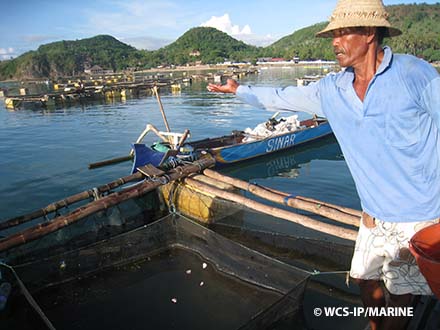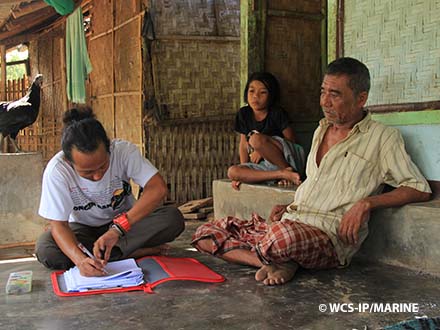
By: Tasrif Kartawijaya
The Bumbang area is fast becoming a center for international and domestic tourism attracted by unspoilt beaches, hidden and secluded coves, amyriad of nearshore coral reefs and – not the least - magical surf where one can find a wave unhindered by the masses who vist Bali. The area also boasts a range of productive pelagic tuna and mackerel, reef snapper and grouper, anchovy and lobster fisheries that local communities source for daily income.
The main threats to the area include blast fishing and cyanide fishing, by outside fishers, which will continue unabated unless zoning systems are developed with full community participation.
Supporting local champions
Key to WCS’ aim of developing a network of Marine Protected Areas (MPAs) in West Nusa Tenggara Province is the support of communities, govermments and private sector. In the Bumbang Sub-districtof southern Lombok, Pak Rokib, a 37 old ex-fisher, has switched jobs to coordinate a more sustainable fishing future for his local people in the region.
His main daily tasks, besides his shop and truck rental businesses, are to help communities to improve their lobster fishing and mariculture practices. Rokib facilitates support from local governments and the private sector to provide technical training and advice to fishers in lobster disease, cultivating, rearing and marketing.

Getting to ‘yes’ for a MPA
Working with Rokib and his fisher and government network, WCS have achieved community and government support to establish a Marine Recreational Park (MRP) in Bumbang Bay on the south-east Lombok coast, where reef and pelagic fisheries and lobster mariculture is expanding.
The proposed area of 22,940 hectares has support from the Ministry of Maritime Affairs and Fisheries (MMAF) and the Central Lombok District Head (Bupati) in the form of adecree to support the preparation of a management and zoning system, establishment of management units, facilities and infrastructure, standard operating procedures, and financial support. Once developed, these will requirefinal legislative approval by the Bupati.
WCS is assisting with collection of ecological, socio economic and resource utilization data to help develop themanagement and zoning system with government and community support.
What sustainable zoning will achieve
By building a system of zones that aim to protect biodiversity, manage fishing gears and potentially set fishing quotas for the lobster and potentially other fisheries, the commitment of government and local communities aim to to reduce threats, improve sustainable production and increase the value of their fisheries by a range of measures that include:
- protection of key nursery habitats
- improved governance and allocation of local fishing rights and
- market incentives that foster implementation of sustainable fishing controls.
Without effective management, the area is most likely to suffer from the same deterioration that has afflicted other parts of Indonesia.
The potential of the lobster
Moreover, WCS has assessed the viability of these fisheries and is establishing a fisheries improvement program (FIP) for the lobster fishery in cooperation with the Sustainable Fisheries Program (SFP). From interviews with local fishers and analysis of lobster catch and fishing pressure we are assessing juvenile lobster stocks in the wild and the levels of sustainable fishing of juvenile lobster, that are transported to and grown to market size in floating fish cages.